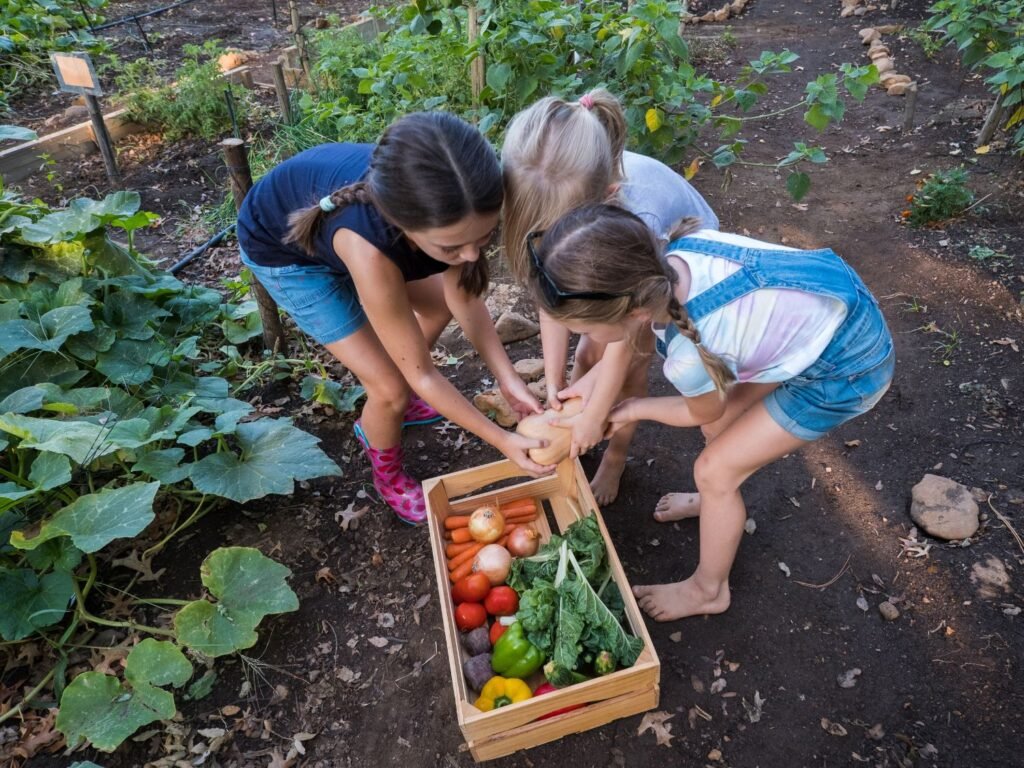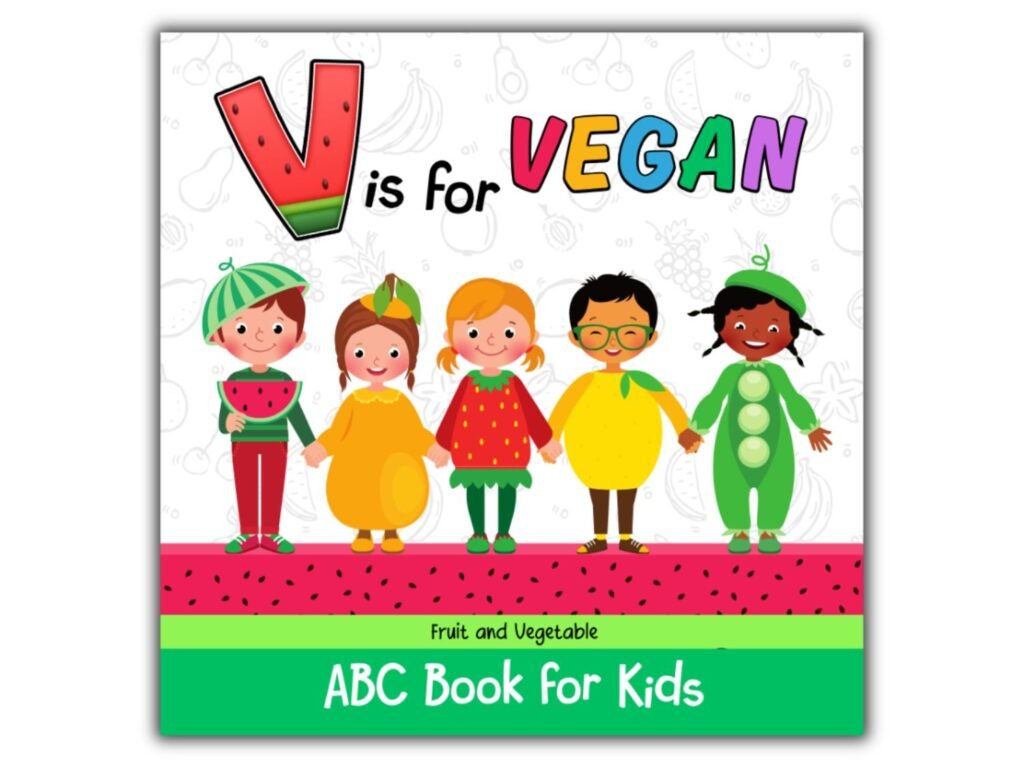Table of Contents
ToggleIn today’s fast-paced world, maintaining a healthy lifestyle is paramount. The growing popularity of veganism reflects a broader societal shift towards sustainable, plant-based diets.
As parents, nurturing children with a solid nutritional foundation and healthy eating habits is both vital and rewarding. Early exposure to fruits and vegetables can instill a lifelong appreciation for plant-based foods.
This article explores effective strategies and creative ideas to help children embrace a vegan lifestyle while relishing the goodness of fruits and vegetables.
Cultivating an Early Connection:
Cultivating an early connection with fruits and vegetables lays a strong foundation for lifelong healthy eating habits. Children are naturally curious and receptive to new experiences, making early exposure to plant-based foods a pivotal opportunity.
Here are further insights into how parents can foster this connection:
1. Hands-On Exploration:
Involve children in the entire food journey, from selection to preparation. Take them to farmers’ markets or grocery stores and encourage them to touch, smell, and select fruits and vegetables. This hands-on experience stimulates their senses and sparks curiosity about different produce varieties.
2. Role Modeling:
Parents serve as powerful role models for children’s dietary behaviors. Demonstrate enthusiasm and enjoyment when eating fruits and vegetables yourself. Share positive stories about your favorite plant-based meals to inspire their interest and curiosity.
3. Gardening Projects:
If space permits, consider starting a small garden at home. Allow children to participate in planting seeds, watering plants, and harvesting produce. This direct involvement in gardening not only teaches them about food cultivation but also fosters a deeper appreciation for the origin of their food.
4. Cooking Together:
Cooking with children can be a fun and educational experience. Let them assist in simple food preparation tasks like washing vegetables, mixing ingredients, or arranging foods on a plate. This involvement in meal preparation empowers children and increases their willingness to try new foods.
5. Variety and Exploration:
Introduce a diverse range of fruits and vegetables to expand children’s palates. Encourage them to taste new foods regularly, even if they initially express hesitation. Experiment with different cooking methods and flavor combinations to make vegetables more appealing and enjoyable.
6. Positive Reinforcement:
Celebrate and praise children’s efforts when they show interest in fruits and vegetables. Offer verbal encouragement and positive reinforcement to reinforce their positive associations with healthy foods.
By cultivating an early connection with fruits and vegetables through these approaches, parents can nurture a genuine appreciation for plant-based foods in children. This early exposure sets the stage for a healthy relationship with food that can positively impact their overall well-being into adulthood.
Fun with Fruits and Vegetables:
Making fruits and vegetables fun and appealing to children is key to fostering their interest and enthusiasm for healthy eating.
Here are creative and engaging ways to make fruits and vegetables exciting:
1. Colorful Creations:
Use a variety of colorful fruits and vegetables to create visually appealing dishes. Arrange sliced fruits like strawberries, oranges, kiwis, and blueberries into rainbow patterns on a plate. For vegetables, make veggie faces or animals using different colored peppers, carrots, cucumbers, and cherry tomatoes. Encourage children to get creative with their own edible artwork.
2. Fun Shapes and Sizes:
Utilize cookie cutters to transform fruits and vegetables into fun shapes. Cut watermelon, cantaloupe, or honeydew melon into stars, hearts, or flowers. Carve cucumbers into zigzag or spiral shapes. Kids will be excited to try these playful creations.
3. Build Your Own Snacks:
Set up a DIY snack station with a variety of fruits and vegetables along with dips like hummus, yogurt, or nut butter. Let children assemble their own fruit kabobs or veggie sticks, fostering a sense of autonomy and creativity in choosing and preparing their snacks.
4. Smoothie Adventures:
Blend fruits and leafy greens into colorful smoothies. Let children choose their favorite fruits to add to the blender and watch as vibrant smoothies come to life. Use fun straws or colorful cups to enhance the experience.
5. Veggie Art:
Turn vegetables into edible art projects. Use sliced cucumbers, carrots, and celery as paintbrushes to dip into hummus or yogurt and create veggie-stamped artwork on whole-grain bread or rice cakes. This activity combines creativity with healthy eating.
6. Frozen Treats:
Make healthy frozen treats using fruits. Blend berries with yogurt and freeze them in ice pop molds for delicious and nutritious popsicles. Alternatively, freeze grapes or banana slices for refreshing snacks on hot days.
7. Storytime Snacks:
Incorporate fruits and vegetables into storytelling or themed snacks. For example, read a book about dinosaurs and serve broccoli trees and carrot sticks as dinosaur food. This makes healthy eating a part of imaginative play.
8. Cooking Adventures:
Involve children in cooking adventures that highlight fruits and vegetables. Bake homemade pizzas and let kids decorate them with colorful vegetable toppings. Make veggie-filled pasta salads or wraps together.
By infusing creativity and playfulness into meal and snack times, parents can make fruits and vegetables enjoyable and appealing to children. These interactive experiences not only encourage healthy eating habits but also create positive associations with plant-based foods that can last a lifetime.

Incorporating Fruits and Vegetables into Everyday Meals:
Incorporating fruits and vegetables into everyday meals is an excellent way to ensure children receive a balanced and nutritious diet.
Here are practical and creative ideas to seamlessly integrate more plant-based foods into your family’s meals:
1. Breakfast Boosters:
Smoothie Bowls: Start the day with colorful smoothie bowls topped with sliced fruits, nuts, and seeds. Let children customize their bowls with their favorite toppings.
Oatmeal Additions: Stir in mashed bananas, berries, or grated apples into oatmeal for a naturally sweet and nutritious breakfast option.
Fruit Pancakes: Add diced fruits like blueberries, bananas, or apples into pancake batter for a fruity twist on a classic breakfast favorite.
2. Veggie-Packed Lunches:
Colorful Wraps: Fill whole-grain wraps with a rainbow of vegetables such as lettuce, carrots, bell peppers, and cucumbers. Add hummus or avocado spread for extra flavor.
Veggie Sushi Rolls: Make sushi rolls using nori sheets, sushi rice, and assorted vegetables like avocado, cucumber, and carrot sticks. Cut into bite-sized pieces for a fun and nutritious lunchbox addition.
Salad Jars: Layer salads in mason jars with leafy greens, cherry tomatoes, chickpeas, and diced fruits. Top with a flavorful dressing for a convenient and refreshing lunch option.
3. Wholesome Dinners:
Stir-Fry Medley: Stir-fry a colorful mix of vegetables such as broccoli, bell peppers, snap peas, and mushrooms with tofu or tempeh. Serve over brown rice or quinoa for a satisfying dinner.
Veggie-loaded Pasta: Toss whole-wheat pasta with marinara sauce and add sautéed zucchini, spinach, and cherry tomatoes. Sprinkle with nutritional yeast or vegan cheese for added flavor.
Plant-Based Pizza: Top whole-grain pizza dough with tomato sauce, sliced vegetables like bell peppers, onions, and artichoke hearts, and finish with fresh basil or arugula.
4. Snack Attack:
Fruit and Nut Mix: Create a trail mix with dried fruits like raisins, apricots, and cranberries, along with nuts and seeds such as almonds, walnuts, and pumpkin seeds.
Vegetable Dippers: Serve vegetable sticks like carrots, celery, and bell peppers with a creamy dip such as hummus, guacamole, or yogurt-based ranch.
Fruity Frozen Treats: Freeze grapes, banana slices, or berries for a refreshing and healthy snack option.
5. Sweet Endings:
Fruit Desserts: Make fruit-based desserts like baked apples with cinnamon, grilled pineapple skewers, or berry compote served over dairy-free yogurt.
Vegan Baking: Use mashed bananas or applesauce as egg substitutes in baked goods like muffins, cookies, or bread, incorporating fruits into sweet treats.
By incorporating fruits and vegetables creatively into everyday meals, parents can ensure that children receive essential nutrients while developing a taste for plant-based foods. These meal ideas offer a balance of flavors, textures, and colors that make healthy eating enjoyable for the whole family.

Cooking and Gardening Activities:
Involving children in cooking and gardening activities is a wonderful way to educate them about healthy eating and sustainability while fostering a love for fruits and vegetables.
Here are engaging and educational activities to try with your kids:
1. Cooking Together:
Vegetable Prep: Let children wash, peel (under supervision), and chop vegetables using child-safe knives. This hands-on involvement builds motor skills and familiarity with different products.
Recipe Exploration: Choose simple recipes like salads, stir-fries, or homemade pizza where kids can assemble ingredients and participate in cooking. Encourage them to taste and adjust seasonings to develop their palate.
Baking Adventures: Bake healthy treats together using fruits and vegetables as the main ingredients. Make banana bread, zucchini muffins, or carrot oatmeal cookies for a delicious learning experience.
2. Indoor Herb Garden:
Start from Seeds: Plant herb seeds (like basil, parsley, or mint) in small pots filled with potting soil. Teach children how to water and care for the plants as they grow.
Harvest and Use: Once the herbs have matured, involve kids in harvesting them for cooking. Use fresh herbs to flavor dishes and show how plants can enhance the taste of food.
3. Vegetable Patch or Container Garden:
Choose Kid-Friendly Vegetables: Select easy-to-grow vegetables like cherry tomatoes, lettuce, carrots, or radishes. Allow children to plant seeds or seedlings in a designated garden area or large containers.
Care and Maintenance: Teach kids how to water, weed, and tend to the plants regularly. Explain the importance of sunlight and soil health in growing strong, healthy vegetables.
Harvest Celebration: Celebrate the harvest by picking ripe vegetables together. Incorporate the homegrown produce into meals to highlight the fruits of their labor.
4. Outdoor Exploration:
Farm Visits: Take children to local farms or community gardens to observe how fruits and vegetables are grown on a larger scale. Engage in farm activities like picking berries or harvesting pumpkins to connect them with food sources.
Nature Scavenger Hunt: Organize a scavenger hunt in nature where children can identify different plants and learn about edible wild foods like berries or herbs (always supervise to ensure safety).
5. Food Education:
Nutrition Lessons: Use cooking and gardening activities as opportunities to discuss the nutritional benefits of fruits and vegetables. Explain the importance of vitamins, fiber, and antioxidants for overall health.
Environmental Awareness: Teach children about sustainable practices such as composting food scraps and reducing food waste. Explain how growing food at home reduces carbon footprint and promotes eco-friendly habits.
6. Creative Projects:
Recipe Book: Encourage kids to create their own recipe book featuring their favorite fruit and vegetable dishes. Have them write or draw each recipe with colorful illustrations.
Garden Journal: Keep a garden journal where children can document plant growth, observations, and gardening experiences. This serves as a valuable learning tool and a keepsake of their gardening journey.
By involving children in cooking and gardening activities, parents can nurture valuable life skills, promote healthy eating habits, and instill a deeper appreciation for fruits and vegetables. These activities also provide quality bonding time and create lasting memories centered around food and nature.

Education through Books and Media:
Utilizing books and media effectively can play a significant role in educating children about the importance of fruits, vegetables, and a vegan lifestyle.
Here are engaging strategies to incorporate educational resources into your child’s learning experience:
1. Children’s Books:
Vegan-Focused Stories: Introduce children to picture books that celebrate plant-based eating and animal-friendly lifestyles. Look for titles that promote positive messages about fruits, vegetables, and compassion for animals.
Nutrition Education: Choose books that explain the nutritional benefits of different fruits and vegetables in a fun and relatable way.
2. Educational Videos and Documentaries:
Kid-Friendly Shows: Explore educational TV programs or online series that emphasize healthy eating and sustainability. Platforms like Netflix or YouTube offer shows that feature cooking adventures with fruits and vegetables.
Nature Documentaries: Watch family-friendly documentaries about farming, gardening, and nature to deepen children’s understanding of where food comes from and why plant-based diets are beneficial for health and the environment.
3. Interactive Online Resources:
Educational Websites: Visit interactive websites designed for kids that promote plant-based nutrition. Websites like National Geographic Kids offer articles, games, and activities related to fruits, vegetables, and healthy eating habits.
Cooking Tutorials: Explore online cooking tutorials specifically tailored for children. Platforms like Tasty Junior or BBC Good Food Kids provide step-by-step videos on making delicious plant-based recipes that kids can recreate with parental guidance.
4. Family Cooking and Storytime:
Cooking Together: Combine storytime with cooking by selecting books that feature recipes inspired by the story. For instance, read a book about apples and then make homemade applesauce together.
Discuss and Reflect: After reading or watching educational content, engage children in discussions about what they learned. Ask open-ended questions to encourage critical thinking and reinforce key concepts.
5. Gardening Resources:
Online Gardening Guides: Access online resources that offer gardening tips and activities suitable for children. Websites like Gardening with Kids or The Spruce provide age-appropriate gardening projects and resources.
Virtual Garden Tours: Explore virtual garden tours or live streams of botanical gardens around the world. This immersive experience allows children to discover different plants and gain inspiration for their own gardening endeavors.
6. Parental Engagement and Role Modeling:
Lead by Example: Show enthusiasm for learning about fruits, vegetables, and veganism alongside your child. Share interesting facts, stories, or cooking experiences that align with the educational content.
Encourage Curiosity: Foster a sense of curiosity and exploration by encouraging children to ask questions about the topics they encounter in books and media.
By leveraging books, videos, online resources, and interactive activities, parents can make learning about fruits, vegetables, and veganism enjoyable and impactful for children. These educational experiences contribute to a holistic understanding of healthy eating and sustainability, shaping positive attitudes towards plant-based lifestyles from an early age.
Engaging in Community Initiatives:
Engaging in community initiatives focused on healthy eating and vegan lifestyles can enrich children’s experiences and reinforce the benefits of plant-based living.
Here are ways to get involved and participate in community activities with your family:
1. Local Events and Workshops:
Farmers’ Markets: Attend farmers’ markets as a family to support local growers and discover fresh, seasonal produce. Many markets host cooking demonstrations or educational sessions about sustainable farming practices.
Healthy Eating Workshops: Look for workshops or cooking classes organized by community centers, libraries, or health organizations. These events often provide hands-on learning experiences and practical tips for incorporating more fruits and vegetables into meals.
2. Volunteer Opportunities:
Community Gardens: Volunteer at a community garden where families can participate in planting, maintaining, and harvesting organic fruits and vegetables. This hands-on activity fosters a connection to nature and promotes teamwork.
Food Pantry Support: Donate surplus produce from your garden or participate in food drives to benefit local food pantries. Teach children about food insecurity and the importance of sharing nutritious foods with those in need.
3. Educational Programs:
School Initiatives: Collaborate with your child’s school to promote healthy eating initiatives. Advocate for more plant-based options in school meals, organize nutrition-themed assemblies, or establish a school garden.
Public Library Resources: Explore resources at your local library, such as storytimes featuring books about healthy eating or environmental sustainability. Libraries often host educational events that support community wellness.
4. Nature Exploration:
Outdoor Activities: Join community nature walks, hiking trails, or outdoor fitness classes that emphasize the benefits of outdoor exercise and connection with natural surroundings. Encourage children to appreciate the beauty of nature while staying active.
Environmental Cleanup: Participate in local cleanup events to protect natural habitats and promote environmental stewardship. Teach children the importance of preserving ecosystems for future generations.
5. Family-Friendly Festivals:
Vegan Festivals: Attend vegan food festivals or plant-based expos where families can sample delicious vegan foods, attend cooking demonstrations, and learn about cruelty-free products. These events provide opportunities to connect with like-minded individuals and businesses.
Health Fairs: Visit health fairs focused on nutrition and wellness, featuring booths with information about the benefits of a plant-based diet. Engage in interactive activities and taste-testing sessions to discover new plant-based products.
6. Online Communities:
Virtual Events: Participate in virtual workshops, webinars, or online forums that promote healthy eating and sustainable living. Connect with experts and other families interested in plant-based lifestyles through social media groups or digital platforms.
7. Advocacy and Support:
Joining Advocacy Groups: Get involved with local or national organizations advocating for sustainable food systems and animal welfare. Participate in campaigns or petitions that support policies promoting healthier food options in communities.
By engaging in community initiatives together, families can cultivate a sense of shared purpose and inspire positive change towards healthier, more sustainable lifestyles. These activities offer valuable learning opportunities and foster a sense of belonging within a supportive community dedicated to promoting plant-based living.
Conclusion:
In conclusion, teaching children to embrace a vegan lifestyle and enjoy fruits and vegetables is a rewarding journey that can positively impact their health, well-being, and connection to the environment. By implementing various strategies discussed in this article, parents can lay a strong foundation for healthy eating habits that will benefit children throughout their lives.
Cultivating an Early Connection through hands-on experiences like visiting farmers’ markets, involving children in cooking, and encouraging exploration of different fruits and vegetables fosters a genuine appreciation for plant-based foods.
Making Fruits and Vegetables Fun by experimenting with colors, shapes, and presentations creates excitement around healthy eating and encourages children to explore new flavors and textures.
Incorporating Fruits and Vegetables into Everyday Meals using creative recipes and cooking techniques ensures that children receive essential nutrients while enjoying delicious plant-based dishes for breakfast, lunch, and dinner.
Engaging in Cooking and Gardening Activities provides valuable learning experiences about food sources, sustainability, and responsibility, instilling a sense of pride and connection with nature.
Utilizing Education through Books and Media exposes children to valuable insights about nutrition, environmental conservation, and compassion towards animals, shaping their attitudes towards a vegan lifestyle.
Participating in Community Initiatives allows families to connect with like-minded individuals, access resources, and contribute to broader efforts promoting healthy eating and sustainability within their community.
Through these collective efforts, parents can empower the next generation with the knowledge, skills, and enthusiasm needed to embrace a vegan lifestyle and make informed choices that support their well-being and the health of the planet.
The habits developed during childhood often carry into adulthood, making it essential to cultivate positive relationships with fruits, vegetables, and plant-based foods early on. By nurturing a love for wholesome, nourishing foods, families contribute to a healthier, more sustainable world while enjoying the journey of discovering the joys of vegan living together. Let’s continue to inspire and educate our children to make mindful choices that prioritize health, compassion, and environmental stewardship. Together, we can create a brighter future for generations to come.
Please note that while this article guides fostering healthy eating habits and engaging children in cooking and gardening activities, I am not a nutritionist. Parents need to consult with qualified healthcare professionals regarding their children’s dietary needs. Additionally, always supervise children during activities mentioned in this article to ensure their safety and well-being.

To continue fostering a love for healthy foods and early learning, take a moment to explore “V is for Vegan: Fruit and Vegetable ABC Book for Kids”
This delightful picture book is designed to spark curiosity and promote letter recognition through colorful illustrations of fruits and vegetables. Grab your copy and embark on an alphabet adventure in the garden with your little ones!
Let’s inspire our children to appreciate the vibrant diversity of fruits and vegetables while nurturing their love for learning and healthy eating habits.

